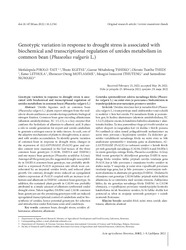Genotypic variation in response to drought stress is associated with biochemical and transcriptional regulation of ureides metabolism in common bean (Phaseolus vulgaris L.).
Date
2022-05-29Author
PHOLO-TAIT, Motlalepula
KGETSE, Thuto
TSHEKO, Gaone Nthabeleng
THEDI, Olerato Tshotlhe
LETHOLA, Katso
MOTLAMME, Ebenezer Oteng
ITHUTENG, Moagisi Innocent
NGWAKO, Samodimo
Metadata
Show full item recordAbstract
Ureidic legumes such as common bean (Phaseoulus valgaris L.) plants export nitrogen from the nodules to shoots and leaves as ureides during symbiotic biological nitrogen fixation. Common bean gene encoding allantoinase (allantoin amidohydrolase, EC 3.5.2.5), is a key enzyme that catalyses the hydrolysis of allantoin to allantoic acid. It plays a role in ureide generation for export and ureide catabolism to generate a nitrogen source in sinks tissues. As such, one of the adaptive mechanisms of plants to drought stress, is associated with ureides accumulation. To identify genetic variation of common bean in response to drought stress, changes in the expression of ALLANTONAISE (PvALN) gene and ureides content were examined in the leaf tissues of the three common bean genotypes (CAL96, DAB514 and DAB541) and one tepary bean genotype (Phaseolus acutifolius A.Gray). Amongst all the genotypes, the suggested drought susceptibility in DAB514 common bean genotype, was probably attributed to a repressed PvALN expression rate which were corroborated by an impaired ureides levels, and reduced plant growth. On contrary, drought stress induced an upregulated relative expression of PvALN coupled with an increase in allantoin and allantoate in DAB541 common bean genotype. In addition, the sustained plant growth in CAL96 was probably attributed to a steady amount of allantoin synthesized under drought stress. Taken together, DAB541 and CAL96 common bean genotypes are the promising genotypes with an induced upregulated transcriptional control of catabolism and/or biosynthesis of ureides, hence potential genotypes for selection and introduction under Botswana semi-arid conditions.
URI
http://ojs.aas.bf.uni-lj.si/index.php/AAS/indexhttps://doaj.org/toc/1581-9175
10.14720/aas.2022.118.2.2541
https://hdl.handle.net/13049/512
Collections
- Reseach articles [146]

